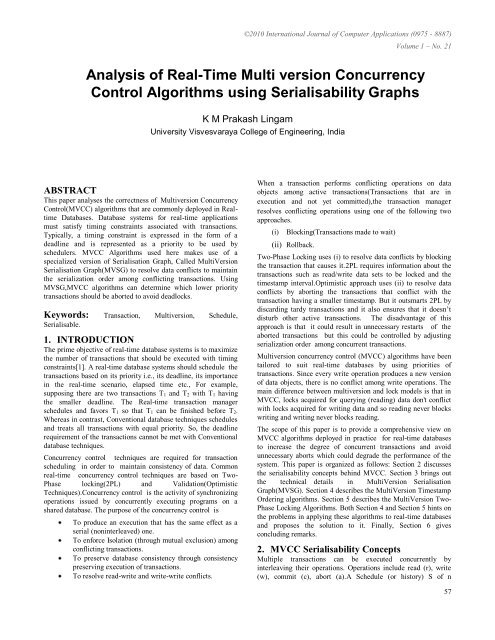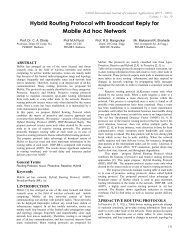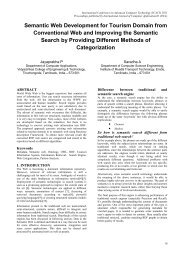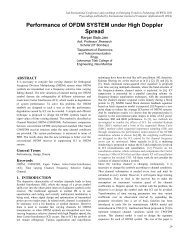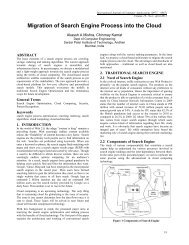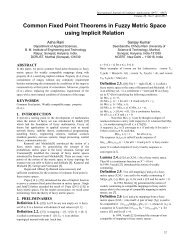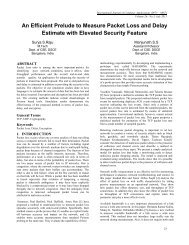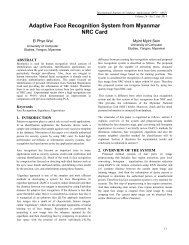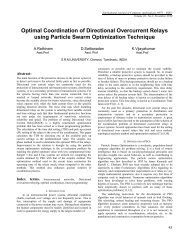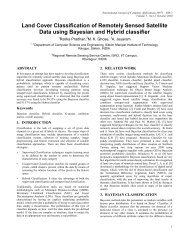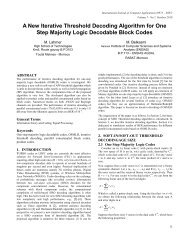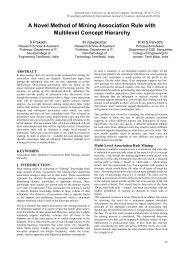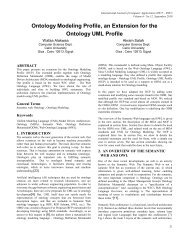View - International Journal of Computer Applications - IJCA
View - International Journal of Computer Applications - IJCA
View - International Journal of Computer Applications - IJCA
Create successful ePaper yourself
Turn your PDF publications into a flip-book with our unique Google optimized e-Paper software.
©2010 <strong>International</strong> <strong>Journal</strong> <strong>of</strong> <strong>Computer</strong> <strong>Applications</strong> (0975 - 8887)<br />
Volume 1 – No. 21<br />
Analysis <strong>of</strong> Real-Time Multi version Concurrency<br />
Control Algorithms using Serialisability Graphs<br />
K M Prakash Lingam<br />
University Visvesvaraya College <strong>of</strong> Engineering, India<br />
ABSTRACT<br />
This paper analyses the correctness <strong>of</strong> Multiversion Concurrency<br />
Control(MVCC) algorithms that are commonly deployed in Realtime<br />
Databases. Database systems for real-time applications<br />
must satisfy timing constraints associated with transactions.<br />
Typically, a timing constraint is expressed in the form <strong>of</strong> a<br />
deadline and is represented as a priority to be used by<br />
schedulers. MVCC Algorithms used here makes use <strong>of</strong> a<br />
specialized version <strong>of</strong> Serialisation Graph, Called MultiVersion<br />
Serialisation Graph(MVSG) to resolve data conflicts to maintain<br />
the serialization order among conflicting transactions. Using<br />
MVSG,MVCC algorithms can determine which lower priority<br />
transactions should be aborted to avoid deadlocks.<br />
Keywords: Transaction, Multiversion, Schedule,<br />
Serialisable.<br />
1. INTRODUCTION<br />
The prime objective <strong>of</strong> real-time database systems is to maximize<br />
the number <strong>of</strong> transactions that should be executed with timing<br />
constraints[1]. A real-time database systems should schedule the<br />
transactions based on its priority i.e., its deadline, its importance<br />
in the real-time scenario, elapsed time etc., For example,<br />
supposing there are two transactions T 1 and T 2 with T 1 having<br />
the smaller deadline. The Real-time transaction manager<br />
schedules and favors T 1 so that T 1 can be finished before T 2.<br />
Whereas in contrast, Conventional database techniques schedules<br />
and treats all transactions with equal priority. So, the deadline<br />
requirement <strong>of</strong> the transactions cannot be met with Conventional<br />
database techniques.<br />
Concurrency control techniques are required for transaction<br />
scheduling in order to maintain consistency <strong>of</strong> data. Common<br />
real-time concurrency control techniques are based on Two-<br />
Phase locking(2PL) and Validation(Optimistic<br />
Techniques).Concurrency control is the activity <strong>of</strong> synchronizing<br />
operations issued by concurrently executing programs on a<br />
shared database. The purpose <strong>of</strong> the concurrency control is<br />
To produce an execution that has the same effect as a<br />
serial (noninterleaved) one.<br />
To enforce Isolation (through mutual exclusion) among<br />
conflicting transactions.<br />
To preserve database consistency through consistency<br />
preserving execution <strong>of</strong> transactions.<br />
To resolve read-write and write-write conflicts.<br />
When a transaction performs conflicting operations on data<br />
objects among active transactions(Transactions that are in<br />
execution and not yet committed),the transaction manager<br />
resolves conflicting operations using one <strong>of</strong> the following two<br />
approaches.<br />
(i) Blocking(Transactions made to wait)<br />
(ii) Rollback.<br />
Two-Phase Locking uses (i) to resolve data conflicts by blocking<br />
the transaction that causes it.2PL requires information about the<br />
transactions such as read/write data sets to be locked and the<br />
timestamp interval.Optimistic approach uses (ii) to resolve data<br />
conflicts by aborting the transactions that conflict with the<br />
transaction having a smaller timestamp. But it outsmarts 2PL by<br />
discarding tardy transactions and it also ensures that it doesn’t<br />
disturb other active transactions. The disadvantage <strong>of</strong> this<br />
approach is that it could result in unnecessary restarts <strong>of</strong> the<br />
aborted transactions but this could be controlled by adjusting<br />
serialization order among concurrent transactions.<br />
Multiversion concurrency control (MVCC) algorithms have been<br />
tailored to suit real-time databases by using priorities <strong>of</strong><br />
transactions. Since every write operation produces a new version<br />
<strong>of</strong> data objects, there is no conflict among write operations. The<br />
main difference between multiversion and lock models is that in<br />
MVCC, locks acquired for querying (reading) data don't conflict<br />
with locks acquired for writing data and so reading never blocks<br />
writing and writing never blocks reading.<br />
The scope <strong>of</strong> this paper is to provide a comprehensive view on<br />
MVCC algorithms deployed in practice for real-time databases<br />
to increase the degree <strong>of</strong> concurrent transactions and avoid<br />
unnecessary aborts which could degrade the performance <strong>of</strong> the<br />
system. This paper is organized as follows: Section 2 discusses<br />
the serialisability concepts behind MVCC. Section 3 brings out<br />
the technical details in MultiVersion Serialisation<br />
Graph(MVSG). Section 4 describes the MultiVersion Timestamp<br />
Ordering algorithms. Section 5 describes the MultiVersion Two-<br />
Phase Locking Algorithms. Both Section 4 and Section 5 hints on<br />
the problems in applying these algorithms to real-time databases<br />
and proposes the solution to it. Finally, Section 6 gives<br />
concluding remarks.<br />
2. MVCC Serialisability Concepts<br />
Multiple transactions can be executed concurrently by<br />
interleaving their operations. Operations include read (r), write<br />
(w), commit (c), abort (a).A Schedule (or history) S <strong>of</strong> n<br />
57
©2010 <strong>International</strong> <strong>Journal</strong> <strong>of</strong> <strong>Computer</strong> <strong>Applications</strong> (0975 - 8887)<br />
Volume 1 – No. 21<br />
transactions T 1,T 2,..T n is an ordering <strong>of</strong> the operations <strong>of</strong> the<br />
transactions subject to the constraint that, for each transaction T i<br />
that participates in S, the operations <strong>of</strong> T i must appear in the<br />
same order in which they occur in T i. However the operations<br />
from other transactions T j can be interleaved with the operations<br />
<strong>of</strong> T i in S.<br />
A schedule S is serial, if for every transaction T participating in<br />
the schedule, all the operations <strong>of</strong> T are executed consecutively<br />
in the schedule, without any interleaved operations from the<br />
other transaction. So it represents inefficient processing and can<br />
lead to low CPU utilisation while a transaction waits for disk<br />
I/O, or for another transaction to terminate, thus slowing down<br />
processing considerably. Every serial schedule is correct because<br />
only one transaction at a time is active - the commit (or abort) <strong>of</strong><br />
the active transaction initiates execution <strong>of</strong> the next<br />
transaction.Therefore, all the serial schedules can leave the<br />
database in a consistent state.<br />
For non-serial schedules the goal is to determine which, are<br />
correct and which are erroneous. The concept used to<br />
characterize schedules in this manner is called serialisability <strong>of</strong><br />
the schedule. A schedule S <strong>of</strong> n transactions is serializable if it is<br />
equivalent to some serial schedule <strong>of</strong> the same n transactions.<br />
Serializable is not the same as being serial. Serializable implies<br />
that the schedule is a correct schedule. So, it will leave the<br />
database in a consistent state. The interleaving is appropriate and<br />
will result in a state as if the transactions were serially executed,<br />
yet will achieve efficiency due to concurrent execution.<br />
2.1 Conflict Equivalence<br />
Eg:<br />
T 1: r(x) w(x) r(y) w(y) c<br />
T 2: r(x) w(x) c<br />
Two operations are said to conflict if they satisfy all three<br />
conditions:<br />
(i) they belong to different transactions<br />
(ii) they access the same item<br />
(iii) at least one is a write operation<br />
Ex.: A sample schedule<br />
S 1: r 1(x) r 2(x) w 1(x) r 1(y) w 2(x) w 1(y)<br />
In the above example, r 2(x) and w 1(x) are conflicting<br />
operations because they satisfy all the above three conditions.<br />
Similarly w 1(x) and w 2(x), r 1(x) and w 2(x) are the other two<br />
conflicting operations.<br />
Two schedules are conflict equivalent, if the order <strong>of</strong> any two<br />
conflicting operations is the same in both schedules. A schedule<br />
is Conflict Serialisable if it is conflict equivalent to some Serial<br />
schedule. Ex: Another sample schedule.<br />
S 2: r 2(x) r 1(x) w 1(x) w 2(x) r 1(y) w 2(x) w 1(y)<br />
Now S 1 and S 2 are conflict equivalent because the order <strong>of</strong> all the<br />
three conflicting operations are preserved. Interleaving <strong>of</strong><br />
operations occurs in an operating system through some scheduler,<br />
which allocates resources to all processes. Factors such as system<br />
load time <strong>of</strong> transaction submission and priorities <strong>of</strong> processes<br />
contribute to the ordering <strong>of</strong> operations in a schedule. It is<br />
difficult to determine how the operations in a schedule will be<br />
interleaved beforehand to ensure serialisability.<br />
2.2 <strong>View</strong> Equivalence<br />
Another less restrictive definition <strong>of</strong> equivalence <strong>of</strong> schedules is<br />
called <strong>View</strong> Equivalence. Two schedules are said to be view<br />
equivalent if they have the same reads-from relationships and<br />
the same writes. The same reads-from relationships amounts to<br />
having the same Read operations. Consider the following<br />
schedule <strong>of</strong> three transactions<br />
T 1: r 1(x), w 1(x) T 2: w 2(x) and T 3: w 3(x)<br />
Schedule S 3: r 1(x), w 2(x) w 1(x) w 3(x)<br />
In S 3, the operations w 2(X) and w 3(X) are blind writes, since T 2<br />
and T 3 do not read the value <strong>of</strong> X. S 3 is view serializable, since<br />
it is view equivalent to the serial schedule T 1, T 2, T 3. However,<br />
S 3 is not conflict serializable, since it is not conflict equivalent<br />
to any serial schedule. In a multiversion concurrency control<br />
algorithm, each Write on a data item x produces a new version <strong>of</strong><br />
x. The Transaction manager(TM) that manages x therefore keeps<br />
a list <strong>of</strong> versions <strong>of</strong> x, which is the history <strong>of</strong> values that the TM<br />
has assigned to x. For each Read(x), the scheduler tells the TM<br />
which one <strong>of</strong> the versions <strong>of</strong> x to read.<br />
The cost <strong>of</strong> maintaining multiple versions is storage space but<br />
still many recovery techniques such as Deferred Update and<br />
Immediate Update requires some before image (BFIM)<br />
information, at least <strong>of</strong> those data items that have been updated<br />
by active transactions. BFIM <strong>of</strong> a data item corresponds to its list<br />
<strong>of</strong> old versions and the recovery algorithm makes use <strong>of</strong> same in<br />
case any active transactions aborts. It is a small step for the TM<br />
to make those versions explicitly available to the scheduler.<br />
The existence <strong>of</strong> multiple versions is only visible to the scheduler<br />
and TM, not to user transactions. Transactions still reference<br />
data items, such as x, y, etc. Users see as if there is only one<br />
version <strong>of</strong> each data item, namely, the last one that was written<br />
from that user’s perspective. When the scheduler decides to<br />
assign a particular version <strong>of</strong> x to Read(x), the value returned<br />
may be one produced by an active or committed transaction. If<br />
the version read is one produced by an active transaction,<br />
recoverability imposes one constraint. The constraint is that no<br />
transaction T in Schedule S commits until all transactions that<br />
have written an item (version <strong>of</strong> data item) that T reads have<br />
committed. In other words, reading transaction’s commitment<br />
would be delayed until the transaction that produced the version<br />
has committed.<br />
In MVCC, multiversion (MV) schedules represent the TM’s<br />
execution <strong>of</strong> operations on a multiversion database, and single<br />
version (1V) schedules represent the interpretation <strong>of</strong> MV<br />
schedules in the users’ single version view <strong>of</strong> the database.<br />
Serial 1V schedules are correct. But the system actually produces<br />
MV schedules. So, to prove that a MVCC is correct, we must<br />
prove that each <strong>of</strong> the MV schedules that it can produce is<br />
equivalent to a serial 1V schedule. For each data item x, the<br />
versions <strong>of</strong> x are designated by x i, x j, . . . , where the subscript<br />
denote the index <strong>of</strong> the transaction that wrote the version. Thus,<br />
each write in an MV history is always <strong>of</strong> the form w i[x i], where<br />
the version subscript equals the transaction subscript. Reads are<br />
58
©2010 <strong>International</strong> <strong>Journal</strong> <strong>of</strong> <strong>Computer</strong> <strong>Applications</strong> (0975 - 8887)<br />
Volume 1 – No. 21<br />
denoted in the usual way, such as r i [x j]. Now, let us consider a<br />
sample MV schedule<br />
S 4 = w 1[x 1]c 1 w 2[x 2] c 2 r 3[x 1]w 3[y 3]c 3<br />
Now, according to the definition <strong>of</strong> conflicts, the operations that<br />
conflict are w 1[x 1]and r 3[x 1]. But w 2[x 2] doesn’t conflict with<br />
either w 1[x 1] and r 3[x 1] because x 2 and x 1 are different data items<br />
i.e. they are different versions <strong>of</strong> x. So, they don’t conflict. Now,<br />
if we map S 4 into an equivalent 1V schedule, we get<br />
S 5= w 1[x]c 1w 2[x]c 2r 3[x] w 3 [y]c 3<br />
The conflicting operations, namely w 1[x 1]and r 3[x 1]in S 4 occur in<br />
the same order in S 5 also. But in S4 , w 2[x 2] doesn’t conflict with<br />
r 3[x 1]but their corresponding 1V operations, namely w 2[x] and<br />
r 3[x] do conflict. So, here applying the conflict equivalence is not<br />
suitable. Moreover, in S 4, T 3 reads x from T 1, whereas in S 5, T 3<br />
reads x from T 2. Since T 3 reads a different value <strong>of</strong> x in S 4 and<br />
S 5, it may write a different value in y. So, S 4 is not view<br />
equivalent to S 5. Let us denote the serialization graph <strong>of</strong> a<br />
schedule S, by SG(S). Now, to prove that every MV schedule<br />
that MVCC can generate is equivalent to a serial 1V schedule,<br />
We will prove that SG <strong>of</strong> an MV schedule is acyclic, thereby<br />
making it serial. Then we will check that every serial MV<br />
schedule is equivalent to serial 1V schedule or not. Now,<br />
consider an MV schedule<br />
S 6 =w 1[x 1]w 1[y 1]c 1r 2[x 1]r 2[y 1]w 2[x 2]w 2[y 2]c 2r 3[x 1] r 3[y 2]c 3<br />
SG(S 6) =<br />
T 1<br />
T 2<br />
T 3<br />
An edge from T i-> T j indicates that T j reads some data item X<br />
from T i. These edges are called as Reads from Edges. Now S 6 is<br />
serial and the corresponding 1V schedule.<br />
S 7 = w 1[x]w 1[y]c 1r 2[x]r 2[y]w 2[x]w 2 [y]c 2r 3[x] r 3[y]c 2<br />
S 6 is not equivalent to S 7 because in S 6 ,T 3 reads x from<br />
T 1, whereas in S 7, T 3 reads x from T 2.Therefore,not all serial MV<br />
schedules are equivalent to serial 1V schedules.<br />
Only a subset <strong>of</strong> serial MV schedules, called l-serial<br />
MV schedules, are equivalent to serial 1V schedules. So, in<br />
order to prove that MVCC is correct, we must prove that its MV<br />
schedules are equivalent to serial 1V schedules.<br />
For this, we will use a modified version <strong>of</strong> serialisation graph<br />
called MultiVersion Serialisation Graph (MVSG). An MV<br />
schedule is equivalent to a l-serial MV schedule iff (if and only<br />
if) it has an acyclic MVSG.<br />
3. MultiVersion Serialisation Graph (MVSG)<br />
We know that two 1V schedules over the same transactions are<br />
view equivalent if they contain the same operations, have the<br />
same reads-from relationships and the same final writes. The<br />
same definition is applicable for MV schedules except the term<br />
final writes can be omitted because if two schedules are over the<br />
same transactions then they have the same writes. Since no<br />
versions are overwritten, all writes are effectively final writes.<br />
Thus, if two MV schedules over the same transactions have the<br />
same operations and the same reads-from relationships, then they<br />
have the same final writes and are therefore view equivalent.<br />
Here the meaning <strong>of</strong> reads from relationship is slightly different.<br />
Transaction T j reads x from T i, in MV schedule S if T j, reads the<br />
version <strong>of</strong> x produced by T i. Next, we will see the equivalence <strong>of</strong><br />
an MV schedule S Mv to a 1V schedule S 1v. S Mv and S 1v must be<br />
over the same set <strong>of</strong> transactions and their operations must be in<br />
one-to-one correspondence. That is,the mapping <strong>of</strong> S Mv to S 1v is<br />
defined by mapping c i to c i, a i to a i, r i[x] to r i [x j] for some version<br />
x j <strong>of</strong> x and w i [x] to w i[x i]. Since the operations <strong>of</strong> S Mv and S 1v<br />
are in one-to-one correspondence, their reads-from relationships<br />
would be the same. All <strong>of</strong> the final writes in S 1v must be part <strong>of</strong><br />
the state produced by S Mv, because S Mv has all versions written in<br />
it. So, just like MV schedules, an MV schedule and 1V S Mv are<br />
equivalent if they have the same reads-from relationships.<br />
[2]Two operations in an MV schedule are said to be conflict if<br />
they are from different transaction ,operate on the same version<br />
and one is a Write. Only one form <strong>of</strong> conflict is possible in an<br />
MV schedule: w i[x i] and r j[x i] conflict provided the former<br />
precedes the latter .The other way is not possible because T j<br />
cannot read x i until it has been produced. Conflicts <strong>of</strong> the form<br />
w i[x i] < w j[x i] are impossible, because each write produces a<br />
unique new version. Thus, all conflicts in an MV schedule<br />
correspond to reads-from relationships.<br />
But since only one kind <strong>of</strong> conflict is possible in an MV history,<br />
SGs are simple to draw. Let S be an MV schedule. SG(S) has<br />
nodes for the committed projection C(S ),which includes only the<br />
operations in S that belong to the committed transactions and<br />
also edge T i-> T j is present iff for some X, r j[x i] (i # j) is an<br />
operation <strong>of</strong> C(S) A serial MV schedule S is 1-serial if for all i,j,<br />
and x, if T i reads x from T j then i = j, or T j is the last<br />
transaction preceding T i, that writes into any version <strong>of</strong> x.In other<br />
words, a serial MV history is 1-serial if for each reads-from<br />
relationship, say T i reads x from T j, Tj is the last transaction<br />
preceding T i, that writes any version <strong>of</strong> x. Schedule S 6 is not l-<br />
serial because w 0[x 0]< w 1[x 1] < r 2[x 0]. Here T 2 should have read x<br />
from T 1 because it has written x last. Consider another sample<br />
schedule:<br />
S 8 = w 1[x 1] w 1[y 1] w 1[z 1] c 1 r 2[x 1] w 2[y 2]c 2 r 3[x 1] r 3[z 1] w 3[x 3]c 3<br />
r 4[z 1] w 4[y 4] w 4[z 4] c 4 r 5[x 3] r 5[y 4] r 5[z 4] . The schedule S 8 is 1-<br />
serial.<br />
[6]An MV schedule is 1- Serializable (or 1SR) if its committed<br />
projection is equivalent to a l-serial MV schedule. A serial<br />
schedule can be 1SR even though it is not 1-serial.<br />
Eg: S 9 = w 1[x 1]c 1 r 2[x 1] w 2[x 2]c 2 r 3[x 1] c 3.<br />
is not l-serial because w 1[x 1]< w 2[x 2] < r 3[x 1].But it is lSR,<br />
because it is equivalent to<br />
S 10 = w 1[x 1]c 1 r 3[x 1] c 3 r 2[x 1] w 2[x 2]c 2<br />
To determine if a MVCC is correct, we must determine if all <strong>of</strong><br />
its schedules are 1SR. MVCC algorithms sort the versions <strong>of</strong><br />
each data item into a total order. MVSG uses this total order <strong>of</strong><br />
versions to include the edges.These edges are called as Version<br />
Order Edges(VOE).[6]<br />
59
©2010 <strong>International</strong> <strong>Journal</strong> <strong>of</strong> <strong>Computer</strong> <strong>Applications</strong> (0975 - 8887)<br />
Volume 1 – No. 21<br />
Given an MV schedule S and a data item x, a version order<br />
denoted by T 5 r 5[z 4] because T 5 reads z from T 4<br />
MVSG(S) is SG(S) with the inclusion <strong>of</strong> version order<br />
edges for any serial MV schedule S.MVSG(S) should be<br />
constructed for SG(S),provided SG(S) is acyclic. If w i[x i] and<br />
r k[x j] are in C(S), then the version order edge forces w i[x i] to<br />
either precede w j[x j] or follow r k[x j] in S.More formally, for each<br />
r k[x j] and w i[x i] in C(S) where i, j, and k are distinct, if x i T j otherwise include T k-> T i as version order<br />
edge. The purpose <strong>of</strong> adding version order edges is to prevent<br />
S’s reads-from relationships from change when version<br />
operations are mapped into data item operations.<br />
MVSG(S 8)=<br />
T 2<br />
T 1 T 4 T 5<br />
T 3<br />
Explanation for MVSG(S 8):<br />
VOE Comments (i,j,k)<br />
T 2 ->T 3 r 2[x 1] and w 3[x 3] since x 1T 4 r 3[z 1] and w 4[z 4] since z 1T 4 w 2[y 2] and r 5[y 4] since y 2 RTS(x k) then set RTS(x k) = TS(T i ).<br />
Eg: If r 3(x) comes for processing and x1 is the version with the<br />
largest timestamp, then the scheduler translates into r 3(x 1) and if<br />
TS(T 3 ) > RTS(x 1),then set RTS(x 1)= TS(T 3 )<br />
It processes w i[x] by considering two cases. If it has already<br />
processed a Read r j[x k] such that TS(T k) < TS(T i) < TS(T j), then<br />
it rejects w i[x] and the transaction T i is aborted and rollbacked.<br />
Otherwise, it translates w i[x] into w i[x i] ,sends it to the TM and<br />
WTS(x i) = RTS(x i)=TS(T j). However, to ensure recoverability, T i<br />
is not allowed to commit until after all the transactions that have<br />
written some versions that T i has read have committed. Since<br />
MVTO need not process operations in timestamp order, a write<br />
could arrive whose processing would invalidate a Read that the<br />
scheduler already processed.<br />
Eg: Suppose in S 11:w 1[x 1] < r 3[x 1] represents the status <strong>of</strong><br />
execution <strong>of</strong> MVTO scheduler. Now suppose if a write w 2[x]<br />
comes and if the scheduler translates into w 2[x 2], then it produces<br />
a schedule that no longer has the same effect as the operations<br />
that are executed in timestamp order on a single version<br />
database. The reason is in S 11, T 3 reads x 1,but it should have<br />
read the value written by T 2,namely x 2.So,the scheduler rejects<br />
w 2[x] it has already processed r 3[x 1] such that TS( T k) < TS( T i)<br />
< TS( T j) where i=2,j=3,k=1 in this example.<br />
Now, if the read and write operations are processed in the above<br />
manner, all the schedules that are generated by MVTO is 1SR.To<br />
prove this, we must prove that MVSG is acyclic. For every edge<br />
T i-> T j in MVSG, if TS( T i) < TS( T j) then MVSG is acyclic.<br />
This must be true for every VOE also. Version order is x i
©2010 <strong>International</strong> <strong>Journal</strong> <strong>of</strong> <strong>Computer</strong> <strong>Applications</strong> (0975 - 8887)<br />
Volume 1 – No. 21<br />
MVSG is acyclic. Hence all the schedules by MVTO is<br />
1SR.So,they are equivalent to serial 1V history.<br />
4.1 MVTO in Real-Time databases<br />
[3][7]Unlike MV2PL, it doesn’t suffer from deadlock. The<br />
problem with timestamp ordering is that there is no apparent way<br />
to bound the number <strong>of</strong> times that a transaction can be aborted.<br />
In the above example, in S 11,if T 2 has higher priority than T 3<br />
,then w 2[x] cannot be rejected. On the contrary, Transaction T 3<br />
has to be aborted. Suppose transaction T j issues an operation on<br />
data item x. ,which conflicts with an operation issued by<br />
transaction Ti . If TS(T i) < TS(T j )does not hold, T j must be<br />
aborted and restarted later with a larger timestamp.<br />
Eg;S 12: w 1[x 1]c 1 w 3[x 3]w 2[x 2] c 2 r 3[x 1]<br />
T 3 will be aborted because the value <strong>of</strong> x 1 is overwritten. If the<br />
MVTO maintains several versions in memory, late read r 3[x 1]<br />
won’t be rejected. Normally version will be deleted from the<br />
oldest to newest in the database.<br />
5.MultiVersionTwo-phase Locking (MV2PL)<br />
A transaction is said to satisfy the two-phase locking (2PL)<br />
protocol if all <strong>of</strong> its locking operations precede the first unlock<br />
operation A transaction satisfying this protocol consists <strong>of</strong> 2<br />
phases - the expanding phase during which new locks are<br />
acquired but no locks can be released and the shrinking phase<br />
during which locks are released but no new lock can be acquired.<br />
In this locking scheme[4], Scheduler uses three types <strong>of</strong><br />
locks, namely, read ,write and certify locks. In the standard<br />
locking scheme with only read and write locks, a write lock is an<br />
exclusive lock. That is, once a transaction obtains a write lock on<br />
an item, no other transactions can access that item. But, this is<br />
not so in MV2PL. The main difference between multiversion and<br />
lock models is that in MVCC, locks acquired for querying<br />
(reading) data don't conflict with locks acquired for writing data<br />
and so reading never blocks writing and writing never blocks<br />
reading. MV2PL allows other transactions to read an item x<br />
while a single transaction holds a write lock on x. This is<br />
accomplished by maintaining two versions for each item x. One<br />
version was written by a committed transaction and the other<br />
versions created by a transaction T that acquires a write lock on<br />
the item x but not yet committed. Other transactions can use the<br />
committed version <strong>of</strong> x while T holds the write lock. T can write<br />
the value <strong>of</strong> x but without affecting the committed version <strong>of</strong> x<br />
that the other transactions uses. This form <strong>of</strong> MV2PL is called<br />
2V2PL because it uses two versions. But ,when T wants to<br />
commit, it must obtain a certify lock on all item that it currently<br />
holds write locks on before it can commit. The certify lock is<br />
exclusive lock. That is, the transaction cannot commit until all its<br />
write locked items are released by any reading transactions.<br />
Therefore, certify lock is not compatible with read locks and this<br />
is illustrated in the lock compatibility table.<br />
Lock Compatibility Table<br />
Read Write Certify<br />
Read Yes Yes No<br />
Write Yes No No<br />
Certify No No No<br />
In 2V2PL,multiple reads can happen concurrently with<br />
single writes .But this comes at the expense <strong>of</strong> transaction’s<br />
delay in commitment until it obtains exclusive certify locks on<br />
all the items that it holds write locks. But this avoids cascading<br />
aborts, since transactions are allowed to ∩ᵩread the committed<br />
version <strong>of</strong> item x. Using more than two versions is called<br />
MV2PL.If the write locks don’t conflict, then any number <strong>of</strong><br />
uncertified versions may be used. It is possible for a transaction<br />
here to read any number <strong>of</strong> uncertified versions but it cannot be<br />
certified until all <strong>of</strong> the versions(uncertified) that it has read are<br />
certified. But, this may result in cascading aborts. Certify lock<br />
can be granted only if there are no read lock on the certified<br />
versions.<br />
[6] We will now prove that all the schedules that are<br />
generated by 2V2PL is 1SR. Let S be a schedule over {T 1, . . .<br />
T n} produced by 2V2PL. Let CEi denote the certification <strong>of</strong><br />
transaction i. Version order is x i
©2010 <strong>International</strong> <strong>Journal</strong> <strong>of</strong> <strong>Computer</strong> <strong>Applications</strong> (0975 - 8887)<br />
Volume 1 – No. 21<br />
6. CONCLUSION<br />
This paper uses serialisation graphs to analyse the correctness <strong>of</strong><br />
MVCC algorithms in real-time databases. Both MVTO and<br />
MV2PL algorithm produces a serialisable schedule. MVTO<br />
algorithm doesn’t incur deadlock and it can decrease the<br />
violation <strong>of</strong> time constraints due to resource waiting. The MVTO<br />
algorithm discussed here also proposes when the lower priority<br />
transaction has to be aborted. Generally transaction aborts<br />
prevents deadlocks, which could degrade the performance <strong>of</strong><br />
real-time database systems. But it will result in wastage <strong>of</strong><br />
system resources.So, aborts should be done whenever necessary.<br />
In 2V2PL / MV2PL,priority inversion could result in<br />
deadlock. But this can be prevented by aborting the lower<br />
priority transaction. But this should be done when the higher<br />
priority transaction wants to acquire certify lock to commit. But<br />
supposing if a higher priority transaction T 2 requests a lock that<br />
conflicts with the lower priority transaction T 1,then T 2 can be<br />
made to wait for T 1 to release the lock. Hence the balance can be<br />
striked between the urgent demands <strong>of</strong> higher priority<br />
transactions and unnecessary aborts <strong>of</strong> the lower priority<br />
transaction.<br />
REFERENCES<br />
[1] Seok Hee Hong,Myoung Ho Kim, “A Real-Time<br />
Concurrency control algorithm:Use <strong>of</strong> Multiversion and<br />
Precedence Relationship,” takenfrom<br />
csd.ks.ac.kr/~shhong/sources/jsa.ps.gz<br />
[2] P.A. Bernstein and N. Goodman, “Multiversion<br />
Concurrency Control-Theory and Algorithms,”ACM Trans.<br />
Database Systems, vol. 8, no. 4, pp. 465-483, Dec. 1983.<br />
[3] R.Abbott, “Scheduling Real-Time Transactions:A<br />
performance Evaluation,” ACM Trans. Database<br />
Systems,Vol.17,no.3 , pp. 513-560, Sep.1992<br />
[4] Elmasri,Navathe, “Fundamentals Of Database<br />
Systems,” 3 rd edition,pp.629-678,Addison –Wesley,1997<br />
[5] P. Bernstein, V. Hadzilacos, and N. Goodman,<br />
“Concurrency Control and Recovery in Database Systems,”<br />
Addison-Wesley, 1987.<br />
[6] “Multiversion concurrency control,”chapter 5 taken from<br />
research.micros<strong>of</strong>t.com/en-us/people/philbe/chapter5.pdf<br />
[7] S.H.Son, “Advances in Real-Time Systems,”PHI,1995<br />
[8] Quilong Han,Haiwei pan, “A Concurrency Control<br />
Algorithm Access to Temporal Data in Real-Time Database<br />
Systems,” imsccs, pp.168-171, 2008 <strong>International</strong> Multisymposiums<br />
on <strong>Computer</strong> and Computational Sciences,<br />
2008<br />
[9] Michael J. Carey and Waleed A. Muhanna. “The<br />
performance <strong>of</strong> multiversion concurrency control<br />
algorithms,” ACM Transactions on <strong>Computer</strong> Systems,<br />
4(4):338{378, November 1986<br />
62


